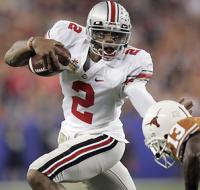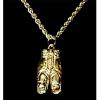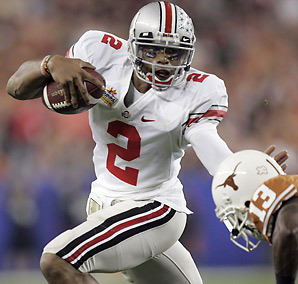 College sports, specifically college football brings in lots revenue for online sportsbooks. It makes money for colleges, advertisers, televisions networks like ESPN and obviously the BCS. The “Student Athletes,” as the NCAA likes to call them, are left out of the money in exchange for an education.
College sports, specifically college football brings in lots revenue for online sportsbooks. It makes money for colleges, advertisers, televisions networks like ESPN and obviously the BCS. The “Student Athletes,” as the NCAA likes to call them, are left out of the money in exchange for an education.
The NCAA has a book of rules that these student athletes need to follow if they want to maintain their scholarships. So much as getting a discount on a tattoo or selling your game worn jersey to a collector is enough to raise the ire of the NCAA. If the player is caught in a violation of the strict NCAA rules, the player can have his scholarship stripped or find himself suspended for part or all of a season.
There is a movement afoot to get these players paid and more importantly to call out the hypocrisy of the NCAA and the BCS in an effort to reward players for risking long term injury to make these governing bodies very wealthy.
Before the creation of the Bowl Championship Series, college teams would play their schedule and then play in exhibition games at the end of the season. When the games were finished College football sports writers would vote on the best team in the nation. It’s was an ideal situation as biases obvious played into the equation.
The Bowl Champions Series is a run by the heads of the six major football conferences. It has essentially created a format in which a multitude of factors are considered to determine the top teams in the nation and of the top teams, the top two would play for the BCS Championship game. The winner would be crowned the National champions.
That brings us to the interesting case of Terrelle Pryor and the Ohio State Buckeyes.
Pryor and four other teammates were found to have violated the NCAA rules by receiving discounted prices for tattoos from a local tattoo shop. This breaks the NCAA rules as the players are not allowed to receive financial or special treatment for playing college sports.
When asked about the tattoos, Pryor said he “Paid for the tattoos.” Tattoos aren’t cheap and if your time in college was anything like my time in college, you can attest to the fact that college students are broke.
Where did Pryor get the money for his tattoos? It turns out he sold his 2008 Big Ten Championship ring, his 2009 Fiesta  Bowl Sportsmanship award and his 2008 Gold Pants, which aren’t really pants but a charm for a necklace. He netted $1250 for the sale. This is a big no-no according to the NCAA.
Bowl Sportsmanship award and his 2008 Gold Pants, which aren’t really pants but a charm for a necklace. He netted $1250 for the sale. This is a big no-no according to the NCAA.
Pryor’s violations didn’t end there, rather they didn’t begin there as the star quarterback has been pulled over by police three times. In each instance he was driving a car from a Columbus Ohio car dealership. His excuse was that he was taking the cars for a test drive. He must have incredibly bad luck with the police or he’s driving a dealers car all the time. Huge NCAA violation.
The Buckeyes are schedule to play in the Sugar Bowl tonight against the Arkansas Razorbacks.
It seems rules are only followed when the NCAA and BCS’s money isn’t at stake as if the NCAA had enforced their own rules, Pryor and his teammates would be suspended for the Sugar Bowl. Instead they found an alternative where Pryor and his OSU teammates will be suspended for the first five games of the 2011 College football season, in exchange for playing in the high-profile moneymaker.
It’s a very unusual move until you hear what Sugar Bowl CEO Paul Hoolahan had to say to the Columbus Dispatch, “I made the point that anything that could be done to preserve the integrity of this year’s game, we would greatly appreciate it…that appeal did not fall on deaf ears.”
It’s a case of the NCAA and the BCS maintaining their cash cow on the backs of amateur players. Had Pryor not played the game would have been a one-way drubbing and hardly compelling TV thus hurting TV ratings, ticket sales and advertising revenues.
The Pryor incident could be the turning point in college sports. I’m not suggesting these kids make millions but at least the NCAA could allow them greater access to money through sponsorships or even free rent and free lunches in the cafeteria.
